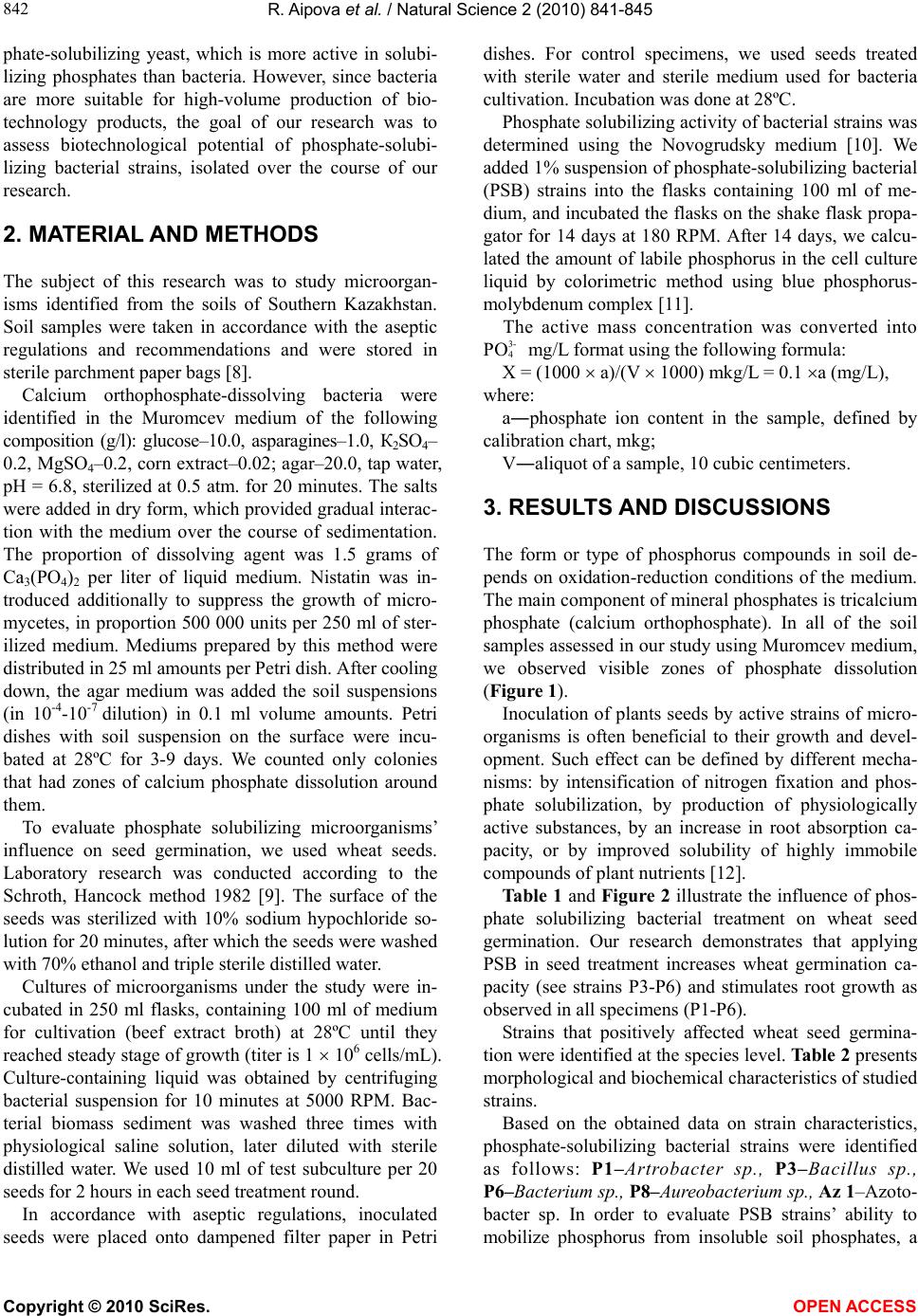
R. Aipova et al. / Natural Science 2 (2010) 841-845
Copyright © 2010 SciRes. OPEN ACCESS
842
phate-solubilizing yeast, which is more active in solubi-
lizing phosphates than bacteria. However, since bacteria
are more suitable for high-volume production of bio-
technology products, the goal of our research was to
assess biotechnological potential of phosphate-solubi-
lizing bacterial strains, isolated over the course of our
research.
2. MATERIAL AND METHODS
The subject of this research was to study microorgan-
isms identified from the soils of Southern Kazakhstan.
Soil samples were taken in accordance with the aseptic
regulations and recommendations and were stored in
sterile parchment paper bags [8].
Calcium orthophosphate-dissolving bacteria were
identified in the Muromcev medium of the following
composition (g/l): glucose–10.0, asparagines–1.0, К2SO4–
0.2, MgSO4–0.2, corn extract–0.02; agar–20.0, tap water,
pH = 6.8, sterilized at 0.5 atm. for 20 minutes. The salts
were added in dry form, which provided gradual interac-
tion with the medium over the course of sedimentation.
The proportion of dissolving agent was 1.5 grams of
Ca3(PO4)2 per liter of liquid medium. Nistatin was in-
troduced additionally to suppress the growth of micro-
mycetes, in proportion 500 000 units per 250 ml of ster-
ilized medium. Mediums prepared by this method were
distributed in 25 ml amounts per Petri dish. After cooling
down, the agar medium was added the soil suspensions
(in 10-4-10-7 dilution) in 0.1 ml volume amounts. Petri
dishes with soil suspension on the surface were incu-
bated at 28ºC for 3-9 days. We counted only colonies
that had zones of calcium phosphate dissolution around
them.
To evaluate phosphate solubilizing microorganisms’
influence on seed germination, we used wheat seeds.
Laboratory research was conducted according to the
Schroth, Hancock method 1982 [9]. The surface of the
seeds was sterilized with 10% sodium hypochloride so-
lution for 20 minutes, after which the seeds were washed
with 70% ethanol and triple sterile distilled water.
Cultures of microorganisms under the study were in-
cubated in 250 ml flasks, containing 100 ml of medium
for cultivation (beef extract broth) at 28ºC until they
reached steady stage of growth (titer is 1 106 cells/mL).
Culture-containing liquid was obtained by centrifuging
bacterial suspension for 10 minutes at 5000 RPM. Bac-
terial biomass sediment was washed three times with
physiological saline solution, later diluted with sterile
distilled water. We used 10 ml of test subculture per 20
seeds for 2 hours in each seed treatment round.
In accordance with aseptic regulations, inoculated
seeds were placed onto dampened filter paper in Petri
dishes. For control specimens, we used seeds treated
with sterile water and sterile medium used for bacteria
cultivation. Incubation was done at 28ºC.
Phosphate solubilizing activity of bacterial strains was
determined using the Novogrudsky medium [10]. We
added 1% suspension of phosphate-solubilizing bacterial
(PSB) strains into the flasks containing 100 ml of me-
dium, and incubated the flasks on the shake flask propa-
gator for 14 days at 180 RPM. After 14 days, we calcu-
lated the amount of labile phosphorus in the cell culture
liquid by colorimetric method using blue phosphorus-
molybdenum complex [11].
The active mass concentration was converted into
РО3-
4 mg/L format using the following formula:
X = (1000 a)/(V 1000) mkg/L = 0.1 а (mg/L),
where:
a―phosphate ion content in the sample, defined by
calibration chart, mkg;
V―aliquot of a sample, 10 cubic centimeters.
3. RESULTS AND DISCUSSIONS
The form or type of phosphorus compounds in soil de-
pends on oxidation-reduction conditions of the medium.
The main component of mineral phosphates is tricalcium
phosphate (calcium orthophosphate). In all of the soil
samples assessed in our study using Muromcev medium,
we observed visible zones of phosphate dissolution
(Figure 1).
Inoculation of plants seeds by active strains of micro-
organisms is often beneficial to their growth and devel-
opment. Such effect can be defined by different mecha-
nisms: by intensification of nitrogen fixation and phos-
phate solubilization, by production of physiologically
active substances, by an increase in root absorption ca-
pacity, or by improved solubility of highly immobile
compounds of plant nutrients [12].
Table 1 and Figure 2 illustrate the influence of phos-
phate solubilizing bacterial treatment on wheat seed
germination. Our research demonstrates that applying
PSB in seed treatment increases wheat germination ca-
pacity (see strains P3-P6) and stimulates root growth as
observed in all specimens (P1-P6).
Strains that positively affected wheat seed germina-
tion were identified at the species level. Table 2 presents
morphological and biochemical characteristics of studied
strains.
Based on the obtained data on strain characteristics,
phosphate-solubilizing bacterial strains were identified
as follows: P1–Artrobacter sp., P3–Bacillus sp.,
P6–Bacterium sp., P8–Aureobacterium sp., Az 1–Azoto-
bacter sp. In order to evaluate PSB strains’ ability to
mobilize phosphorus from insoluble soil phosphates, a